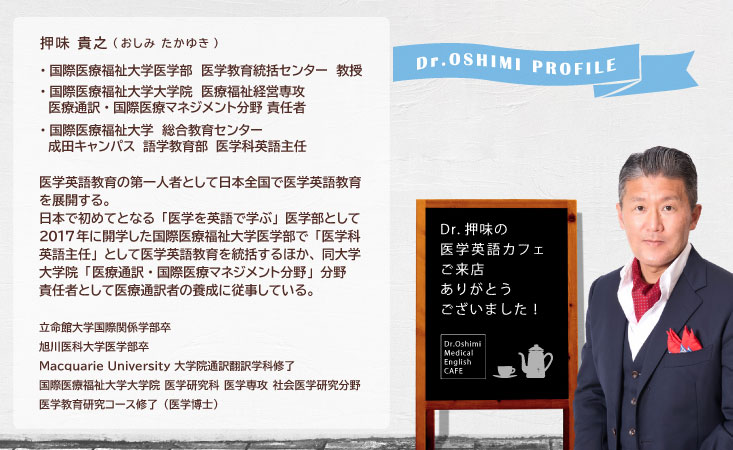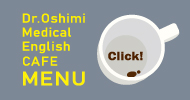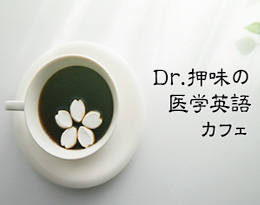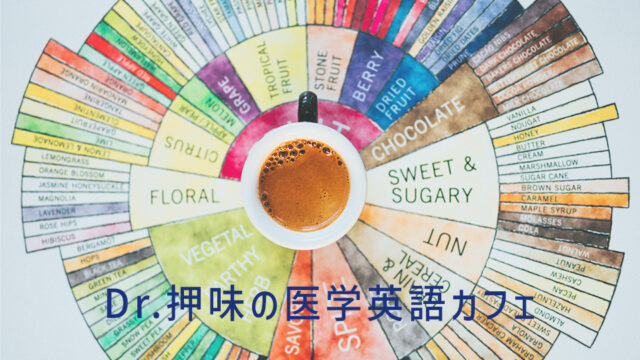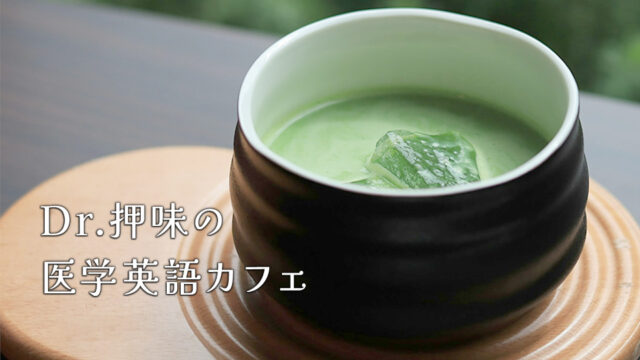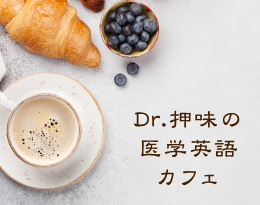
こんにちは。「医学英語カフェ」にようこそ。
ここは「コーヒー1杯分」の時間で、医学英語にまつわる話を気軽に楽しんで頂くコーナーです。
本日のテーマは「3分で研究をわかりやすく伝える英語スキル」です。
皆さんは 3MT という表現を聞いたことがありますか?
Three Minute Thesis(3MT©️)とは、「博士課程の学生が自分の研究を3分で説明する国際的なプレゼンテーションのコンテスト」のことです。
この 3MT では通常の研究発表とは異なり、「短時間に一般の人にもわかりやすく伝える力」が求められます。学術界だけでなく、社会に対してもわかりやすく伝える力が重要になっている現在、この 3MT で求められる英語スキルを身につければ、研究費の獲得の際に説得力を持つだけでなく、ポスター発表などでの elevator pitch としても応用することができます。
そこで今月はこの 3MT に着目し、「3分で研究の要点をわかりやすく一般の人に説明する英語スキル」を紹介したいと思います。
3MTって何?
英国や豪州では「修士論文」のことを dissertation と、そして「博士論文」のことを thesis と呼びます。(北米ではこれが逆となり、「修士論文」のことを thesis と、そして「博士論文」のことを dissertation と呼びます。)
この thesis「博士論文」にちなんで名づけられたのが、Three Minute Thesis (3MT©️)です。これは「大学院の博士課程に在籍する学生が、3分で自身の PhD Thesis の要点を非専門家にもわかりやすく伝えるプレゼンテーションのコンテスト」のことです。使用できるスライドは1枚のみで、原稿の持ち込み、動画・音声、小道具などは全て禁止されています。自分の研究内容に詳しくない聴衆に向けて、明確で簡潔、かつ魅力的に伝える技術を競い合います。
この3MTは、2008年に豪州のUniversity of Queensland (UQ) で誕生しました。当時、Queensland州では深刻な干ばつにより「シャワーは3分以内に」という節水キャンペーンが展開され、多くの家庭で3分タイマーが使われていました。これにヒントを得たUQの大学院部長 Alan Lawson教授が「限られた時間で研究の要点を伝える力」に着目し、この 3MTのコンセプトを生み出したそうです。
その後、3MT は豪州の他の大学にも広まり、2011年以降は国際的に開催されるようになりました。今では世界85カ国以上、900以上の大学で開催される世界規模のプレゼンテーション大会に成長しています。
現在、大学院生や研究者には自身の研究を「社会に向けてわかりやすく伝える力」も求められています。こうした背景には、大学が研究活動をこれまでよりも積極的に社会に向けて発信する必要が生じていること、研究発表そのものが制限時間や勝敗といった要素を伴うゲームのような形式で行われるようになってきたことなどが挙げられます。さらに YouTube や Podcast といった短時間でインパクトを与えるデジタルメディアの普及により、研究者にも「短時間で伝える力」が期待されています。このように表現力そのものに注目が集まるようになった現在、3MTは時代の要請に応えるスキルをトレーニングする場としても意義を持っているのです。
3MT の評価基準は?
3MTの審査では「非専門家にもわかりやすく伝えられているか」が重要視され、その Judging Criteria「審査基準」は下記のようになっています。
Comprehension and Content「内容が明確であるか」
- • なぜその研究を行うのかが明確に語られているか
- • 研究の方法・結果・発見がわかりやすく説明されているか
- • 結論やその研究の意義がしっかりと伝わっているか
Engagement and Communication「一般の人にもわかりやすく話しているか」
- • 難しい言葉を避け、誰にでも伝わる表現で話せているか
- • スライドがシンプルで内容を効果的に補っているか
- • 話し方に熱意があり、聴衆の興味を引きつけ続けているか
通常、研究発表では「学術界からの信頼」である academic credibility/academic cred を得ることが目的となりますが、3MT では「一般人からの信頼」である street credibility/street cred を得ることが重要視されているのです。
内容を明確にするために3MT で使われる「型」とは?
Comprehension & Content「内容が明確であるか」の審査基準を満たすため、3MT では医歯薬・生物学系の発表で一般的な IMRaD形式(Introduction, Methods, Results, and Discussion)とは異なる「型」が使われています。
通常の研究発表では下記の項目を均等なバランスで言及することが一般的です。
- 1. Background (Why?): なぜその研究を行なったのか?
- 2. Methods (How?): どのようにして研究を行なったのか?
- 3. Results (What?): 何が発見されたのか?
- 4. Conclusion (So what?): 何が結論づけられるのか?
しかし 3MT では「なぜその研究を行うのか?」の部分が最重要となるので、Background の部分に重点を置いた構造となります。
もちろん 3MT には発表者の数だけ異なる構造があるのですが、優秀な 3MT には共通の「型」も存在します。私が教鞭を取っている国際医療福祉大学医学部では、下記の7つの項目を取り入れた「型」を推奨しています。
- 1. Opening: 研究に興味を持ってもらうための導入部分。最後の Take-Home Messages と関連させるとより効果的。
- 2. Explain the Keyword: 研究において重要となる keyword を平易な言葉で解説し、聴衆の理解を助ける。
- 3. Describe the Issue: この研究が解決しようとする問題の重要性を指摘する。
- 4. Research Question: その課題を解決するために設定された具体的な research questionを提示する。
- 5. Methods: どのような手法を用いて研究を行ったのかを簡潔に説明する。
- 6. Results: 主要な結果を図や数値を使わずに平易な言葉で要約する。
- 7. Take-Home Messages: 聴衆に伝えたい最も重要なメッセージを formal English ではなく plain English で伝える。導入部分と関連させるとより効果的。
上記7つの項目のうち、1から4まではBackground で通常述べられる内容です。3MT の準備として「どのような構造にしていいかわからない」と悩んでいる方は、まずはこの「型」を使って準備を進めてみてください。
一般の人にもわかりやすく伝えるコツとは?
Engagement and Communication「一般の人にもわかりやすく話しているか」の審査基準を満たすためには、「take-home messages を伝えるために不要な情報は削ぎ落とす」「一般の人が馴染み深い例を使う」「最後に導入で述べた話題を回収する」といった工夫が必要となります。
では実際の 3MT において、具体的にどのような工夫がされているのでしょうか?
ここから実際に行われた2つの 3MT の動画を見ていきましょう。
1つ目の 3MT はこちらの研究に関するものです。ここで見られるabstract「抄録」 は academic cred を得るための構造となっていますが、下記の 3MT ではstreet cred を得るために、abstract とは大きく異なる構造となっています。
“Do we need memory clinic pharmacists?” by Amanda Cross
Opening
The Avengers. The Justice League. The Guardians of the Galaxy. What do they all have in common? They all involve a specialized team working together towards a common goal.
Now my PhD is not about Marvel superheroes, but it is about a team, the memory clinic team. A memory clinic involves a specialized team of health professionals including doctors, psychiatrists, nurses, and social workers, who assist people with suspected or confirmed memory problems. Pharmacists are not typically part of the memory clinic.
冒頭では、発表当時人気だったスーパーヒーローのチーム名を挙げています。自分の研究も memory clinic というチームに関するものであるという論理展開で始めています。
Explain the Keyword
A key role of the memory clinic is to identify factors that may cause or worsen a person’s memory. One of these factors is the use of inappropriate or unnecessary medications. We know that some medicines, including sedatives and anticholinergics are considered inappropriate for use in a person with memory problems due to their high risk of causing sedation, confusion, and further memory loss.
次にこの研究の keyword である memory clinic を説明しています。
Describe the Issue
But surely people with memory problems are not taking medicines that can make their memory worse, right? Unfortunately, it seems they are. In fact, my early research has shown that over a 3-year follow-up period, one in three people who attended a memory clinic to one or more inappropriate medications. What’s worse is that the use of these medicines was associated with higher risk of death. Ladies and gentlemen, action is needed.
ここではあまり細かくなり過ぎない程度に数字を用いて、「memory clinic における不適切な薬の服用」という解決すべき問題を提示しています。
Research Question
Could pharmacists, the medication experts, help improve medication use in this vulnerable population? My PhD aims to address this question.
ここでresearch question を簡潔に示し、研究の目的をわかりやすく提示しています。
Methods
My current research has involved adding a pharmacist into a major Melbourne memory clinic. The pharmacists have been responsible for conducting comprehensive home medication reviews to help identify inappropriate and unnecessary use. The pharmacist then works with the patient, the memory clinic, and the GP to develop a plan to reduce and ideally stop inappropriate medications.
何を行なったかを簡単な動詞を使って説明しています。
Results
Now this intervention has the potential to greatly improve medication use, reduce harmful medication side effects, and increase quality of life. The study is ongoing but results today are extremely positive.
具体的な数字を示すのではなく、どのような効果があったのかを説明しています。
Take-Home Messages
So, it seems just as the Avengers need Thor. Justice League needs Wonder Woman, and the Guardians of the Galaxy need Groot. Memory clinics need pharmacists. Thank you.
導入部分と関連させて「スーパーヒーローのチームにそれぞれ必要な仲間がいるように、memory clinicにも薬剤師が必要である」という簡潔な take-home message で締め括っています。
いかがでしたか?“Memory clinics need pharmacists.” という take-home message を伝えるために不要な情報は全て削ぎ落とし、聴衆にとって馴染み深いスーパーヒーローの話題を冒頭で言及し、それを上手く take-home message に関連させて締め括っています。
2つ目の 3MT はこちらの研究に関するものです。こちらもstreet cred を得るため、abstract とはかなり異なる構造となっています。
“Mapping the Most Efficient Drug Route into the Brain” by Nazira Albargothy
Opening
Allow me to take you own a journey of a disease that erases your entire memory from the first holiday you spent with your family to tying your shoelaces. In the world, there are 46 million individuals suffering from dementia. In fact, one in three of us sitting here today is at risk of developing a memory impairment disease, an example of which is Alzheimer’s disease.
共感を呼ぶ形で記憶の重要性を強調し、3人に1人が記憶障害のリスクがあるという事実で観客の注意を惹きつけています。
Describe the Issue
To understand what happens in Alzheimer’s, I would like you to imagine the blood vessels in a normal healthy brain as unblocked motorways. Waste products are officially cleared out along these intact roads. As we age, these roads become damaged with potholes and toxic proteins begin to accumulate in them. Traffic slows down and eventually leads to a complete failure of brain function.
Many drugs have been developed to resolve this traffic, but a major issue with drug administration to the brain is that the brain is separated from the rest of our body by a highly selective barrier known as the blood-brain barrier to prevent the entry of unwanted substances. Therefore, injecting drugs into the blood of patients for treatment isn’t always effective.
「道路が損傷し、ゴミが溜まることで交通が妨げられる」という日常的なイメージでアルツハイマーの病態を説明しています。また「脳血液関門の存在で、血液から脳に薬を効率的に届けることができない」という問題を提示しています。
Explain the Keyword
But there is another route, and that is to inject drugs directly into a fluid known as the cerebrospinal fluid
or CSF. This fluid is in direct contact with the brain and runs all the way down a spinal cord. However, this route is not well understood. This is where my project comes in.
この研究の keyword は cerebrospinal fluid (CSF) ですが、これは「脳血液関門の存在で、血液から脳に薬を効率的に届けることができない」という問題を提示した後に述べないと意味がないので、Describe the Issue の次という順序になっています。
Research Question
I’m Nazira Albargothy, and I’m funded by Biogen pharmaceuticals to create a map of the exact pathway of drug entry into the brain from the CSF. And I present it to you here as a Google Brain Map with the routes corresponding to the drug pathways.
使用しているスライドで Google Maps をイメージさせ、脳に薬を届けるための Google Brain Map を作ることが研究の目的であることを示しています。
Methods
To achieve this, I injected drugs into the CSF of normal and diseased mouse models and explored where they went. And I have some findings.
複雑な実験内容を injected や explored などのシンプルな動詞で表現し、視覚的に想像しやすいように説明しています。
Results
I identified the exact routes along which these drugs enter the brain from the CSF. And more importantly, I found that some drugs penetrated the better than others. This already tells us that the CSF route has major capacity for efficient drug delivery to the brain. And we may even be able to direct different drugs to different brain regions based on the characteristics of the drug.
「薬ごとに浸透ルートが違う」という重要な発見をわかりやすく提示するだけでなく、脳疾患治療への応用といった社会的意義に繋がる形で結果を提示しています。
Take-Home Messages
This is just the beginning, and I hope by the end of my PhD, I’ll construct a Google brain map to plan the most efficient drug journey into the brain to the development of therapeutic targets for Alzheimer’s disease. Thank you all for listening.
「Google Mapsのような Google Brain Mapを作りたい」というわかりやすいメッセージで締め括っています。
いかがでしたか?このように実際の 3MT では、street cred を得るために下記のような工夫がされています。
- • take-home messages を伝えるために不要な情報は削ぎ落とす
- • 一般の人が馴染み深い例を使う
- • 最後に導入で述べた話題を回収する
このように背景・文脈に合わせて構造を再構築する作業をrecontextualisation「再文脈化」と呼びます。現在は研究者にもこの recontextualisation の能力が求められる時代となっているのです。
ポスター発表にも応用できる? 3MT を応用した elevator pitch とは?
「Menu 75: 学会に関する英語表現」でも紹介しましたが、Poster Presentation では聴衆との双方向のやりとりが求められます。そしてそのような双方向性のやり取りでは elevator pitch と呼ばれる短時間での説明が求められます。その際には「3分」「1分」「30秒」という3つの elevator pitch を用意し、必要に応じてそれら3つを使い分けるのが理想的です。
この「3分」の elevator pitch に、今回ご紹介した 3MT の「型」を使ってみましょう。こうすることで自分の研究分野に精通していない聴衆にも、研究の重要性を上手く伝えることができるはずです。
3分の elevator pitch = 3MTの「型」
- 1. Opening: 最初の「掴み」
- 2. Explain the keyword: 研究のキーワードの説明
- 3. Describe the issue: 研究が解決する問題の説明
- 4. Research question: 研究が解明する疑問
- 5. Methods: 方法
- 6. Results: 結果
- 7. Take-home messages: 結論
そして「1分」と「30秒」の elevator pitch では、この3MT の「型」を短縮し、それぞれ下記のような「型」で準備すれば良いのです。
1分の elevator pitch
- 1. Describe the issue: 研究が解決する問題の説明
- 2. Research question: 研究が解明する疑問
- 3. Methods: 方法
- 4. Take-home messages: 結論
30秒の elevator pitch
- 1. Research question: 研究が解明する疑問
- 2. Take-home messages: 結論
このような3つの elevator pitch を準備しておけば、自信を持ってポスター発表にも臨めることでしょう。
さてそろそろカップのコーヒーも残りわずかです。最後にChatGPT などのAI を使って、abstract を 3MT の「型」に変換するための prompt を示します。ご自身の研究の abstract を最後に添付して、皆さんオリジナルの3MT の原稿を作ってみてください。
Transform the following abstract into a script for a 3-minute oral presentation in the 3MT-style format. Please organize the content as follows:
- 1. Opening: Provide a brief introduction to the topic.
- 2. Explain the Keyword: Define any specialized terms or key concepts.
- 3. Describe the Issue: Clearly outline the main problem or challenge the research addresses.
- 4. Research Question: Clearly state the primary research question or objective.
- 5. Methods: Briefly summarize the methodology used in the research.
- 6. Results: Highlight the key findings.
- 7. Take-Home Messages: Conclude with the implications of the research, presented in plain English.
Abstract: [Insert your abstract here]
では、またのご来店をお待ちしております。
「Dr. 押味の医学英語カフェ」では、読者の皆さまがこの連載で取り上げてほしい医学英語のトピックを募集しています。こちらのリンクよりご希望のトピックを自由に記載してお送りください。
国際医療福祉大学医学部 医学教育統括センター 教授
押味 貴之



